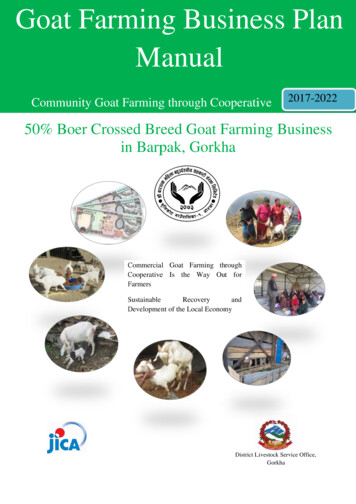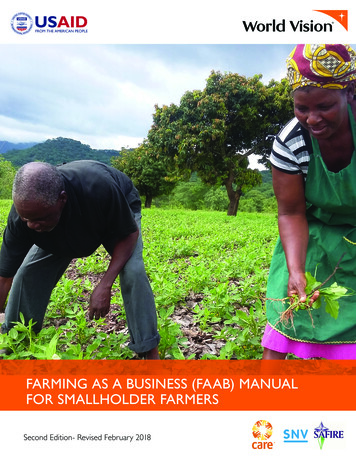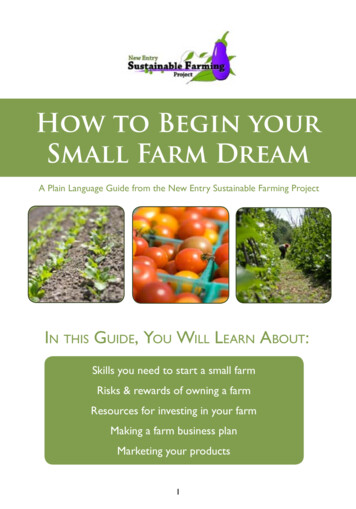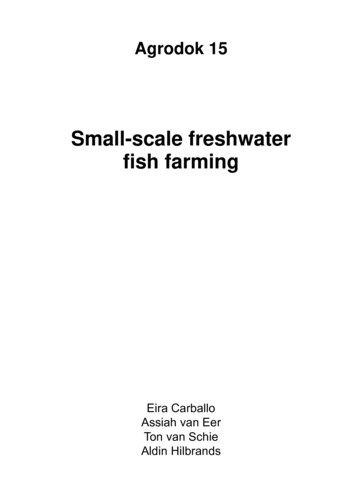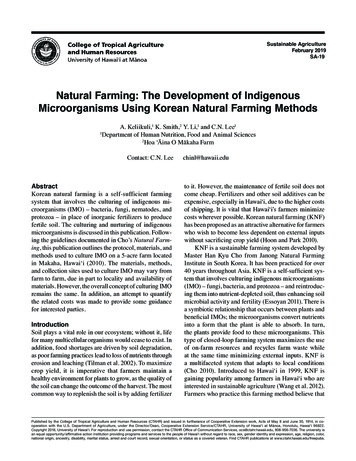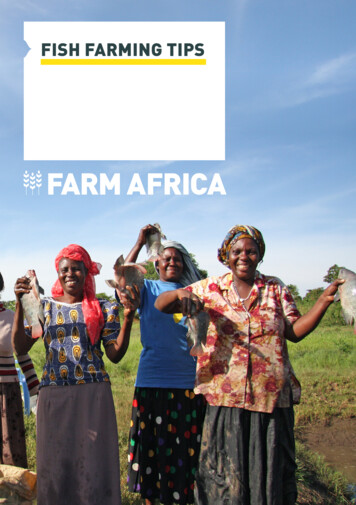
Transcription
FISH FARMING TIPS
Wild fish stocks in Lake Victoria are dwindling.Tilapia, which is widely eaten across Kenya, is gettingparticularly scarce.Farm Africa’s Kenya Market-led Aquaculture Programme(KMAP) is promoting fish production in ponds to:help protect Lake Victoria’s strained resources.provide a growing population with a sustainablesource of fish.enable fish farmers to build thriving businesses.Farm Africa reduces poverty by unleashing African farmers’abilities to grow their incomes in an environmentallysustainable way.The KMAP programme is looking to work with mid-level farmerswho have at least three commercial fish ponds.
IS GROWING FISH SOMETHING FOR YOU?Like most other types of farming, fish farming is a riskybusiness that requires specialist knowledge, skills, and ahigh initial investment.Complete this quick checklist to find out if fish farming isfor you:YES NODo you own suitable land with a good source ofhigh-quality water?Is there sufficient demand for the fish you wantto grow?Can you really devote the money, time and labournecessary?Do you have enough resources to purchase feed forthe whole production cycle? Quality feed will giveyou the best results: you need about 450kg of feedto grow 300kg of fish in a 300m2 pond. With lowerquality feed you might need 900-1500kg of feed.Is the water temperature optimal for the fishspecies reared?Have you identified and are you able to deal withrisks such as thieves, flooding, etc?
TILAPIA FARMINGTilapia can be reared in earthen ponds, ponds with liners, cagesand raised tanks.Maximum stocking density:Stocking numbers of fish for different feed qualities.The average weight for a fish at harvest is estimated at 200 grams.Productionsystem based oninputsRecommendeddensity atharvestin kg/m²Number offish per m²(fish of 200geach)Green water(fertilisation only)no other feedsavailableCommunity fishfeeds availableCommercial fishfeeds available0.3 - 0.51.5 - 2 fish0.6 - 0.83 - 4 fish0.8 – 1.04 - 5 fishIntensive fishfarmingUp to 150kg/m2Only for closed circulation systems(needs 24/7 electricity, which makes itexpensive)Green waterLow costsLow productionLess workNumber of200g fishin a 300m²pond atharvestNumber offingerlingsto bepurchasedat 10%mortality450 - 600 fish 500 – 700900 – 1,200fish1,200 – 1,500fish1,000 –1,3501,350 –1,700Commercial feedHigher investment neededHigh productionMore workFeed money!Feeding fish is throwing money in the pond; make sure it is moneywell spent. As a rule of thumb, never feed pellets that are biggerthan the eye of your fish.
CATFISH VERSUS TILAPIAGrowth in six monthsStocking densitywithout aerationMarket and priceDemandFeedCatfishMax 1kgMax 5kg/m2TilapiaMax 350 gramsMax 1kg/m2Not everywherePrices between250-400Ksh/kgLowMore expensive(needs more protein)Anywhere at a good price(300-500Ksh/kg)Very highCheap, can even be grownin ponds that are fertilised
ESSENTIAL EQUIPMENT ON FARMFor a serious farmer it is importantto know exactly how muchequipment is needed.Every farm should have a:WEIGHING SCALEfor fish and incoming feed (10-50kg)(precision 100 grams) and aweighing scale for samplingand measuring feeds (0-5 kg)(precision 1 gram)preferably digitalMEASURING TAPE(minimum 10 metres)CALCULATORHARD COVER BOOKto record your daily, weekly,monthly and harvest records*When you intensify it is important to alsomonitor your water quality.pH, Ammonia, Nitrate and Nitriteare key elements to monitor.Once you are large scale you shouldalso monitor oxygen levels.
HOW TO FEED YOUR FISHFeed the fish twice a day, in the morning and early afternoon.Recommended feeding times are between 11am and 4pm.Always feed the fish at the same time and at the same placeof your pond. You can “call” your fish by knocking on the feedbucket or making a sound. Fish will learn fast when andwhere to get the feed. Try to attract the fish to the feedingplace by only throwing a small amount of feed over a largerarea of the pond at the beginning of your feeding session.If the fish are not responding, stop the feeding!Don’t feed your fish when they are not responding. This couldbe an indication of low temperature or water quality problems.
HOW AND WHERE TO SELL YOUR FISH?Before you start fish farming you should have studied the market.Make sure that you produce what you can sell, eg a student cannotbuy a 400 gram fish, but would be more likely to buy a smaller, lessexpensive fish.The client is king: notify your customers one to two weeks beforeharvesting, it is good to bring a sample before so there are nosurprises, which will mean you will have to re-negotiate the fishthey want. Figure out what size and how they want the fish: whole,gutted, descaled, deep fried?Plan early to avoid surprises and do not let your customers down;give honest and good information. This way you will make goodmoney and have customers for the next harvests.
STOCKINGCATFISH:Make sure you stock fish of the same size.TILAPIA:Stock the pond with all male tilapia fingerlings.All male means that over 98% of the fish are male.The use of mixed sex tilapia is not recommended because:1) Males grow faster than females2) Mixed sex tilapia will start to reproduce after a few monthsSpending a bit more money on buying good-quality, male tilapiafingerlings of good size from your trusted fingerling producer willpay off at harvest!
FEEDSMake sure you check the feeds before you accept delivery or beforeyou buy. Weigh the bag and make sure that it has the quantity it claimsto have on the bag. Store the bags on a pallet off the floor and not against the wall. Make sure the bags and the feed are dry and free of mould. Verify the size and shape of the pellets (they should be almostround). If they claim the feed is floating: try it in a bucket with somewater and check that at least 80% of pellets are still floatingafter 30 minutes. You can also have the protein and fat content tested, ask yourAqua Shop or agent where this can be done.FISH SAMPLINGSample your fish every month to calculate the total weight andindividual weight. This allows you to calculate the growth, dailyfeeding rations and food conversion ratios (FCR). You can onlyestimate the population of your fish after sampling.FISH HARVESTINGFish should be ready to harvest within six to nine months.Stop feeding the fish two days before harvest. Prepare the tools(seine net, plastic buckets, weighing scale) and labour for harvesting.Harvesting is done early in the morning. During harvesting, handlefish with care to avoid damage and post-harvest losses; always wetyour hands/equipment and keep the fish as long as possible in thewater. Partially drain the pond very early on the day of harvest.
Farm Africa works directly with farmers, suppliers andtraders to improve the production and marketing of fish.We do this by: Providing training for fish farmers and helping them to accesshigh-value markets to increase their incomes. Supporting the suppliers of feed and fingerlings (young fish) toimprove the quality of their produce and helping them to sell tofarmers. Working with traders to increase their access to markets andcapacity to sell larger volumes of farmed fish. Carrying out an educational campaign to show the benefits offarmed fish over wild-caught fish. Helping fish farmers to organise themselves into tradeassociations so that the industry can thrive.
Fish farming has the potential to make a significant contribution tonutrition, income generation and employment in Kenya. This bookletcontains useful tips to help fish farmers build thriving ngFARM AFRICA KENYAPO Box 4950200100 NairobiKenyaT: 254 20 273 1664F: 254 20 273 2086Photos: Eleanor Whiteman,Mwangi Kirubi
Feed the fish twice a day, in the morning and early afternoon. Recommended feeding times are between 11am and 4pm. Always feed the fish at the same time and at the same place of your pond. You can “call” your fish by knocking on the feed bucket or making a so
